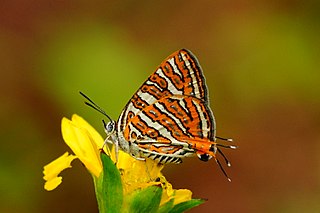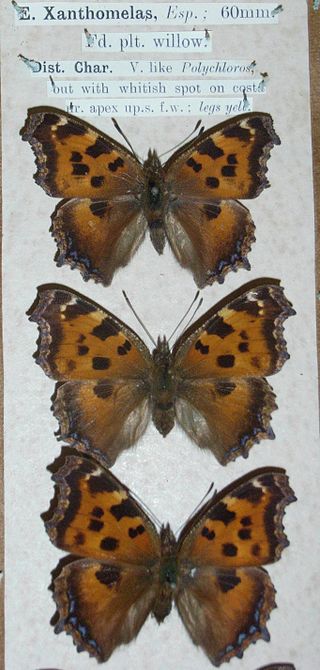
Elymnias hypermnestra, the common palmfly, is a species of satyrine butterfly found in South and Southeast Asia.

Zizula hylax, 'the Tiny grass blue' is a species of blue butterfly.

Hypolimnas misippus, the Danaid eggfly, mimic, or diadem, is a widespread species of nymphalid butterfly. It is well known for polymorphism and mimicry. Males are blackish with distinctive white spots that are fringed in blue. Females are in multiple forms that include male-like forms while others closely resemble the toxic butterflies Danaus chrysippus and Danaus plexippus.

Cigaritis vulcanus, the common silverline, is a species of lycaenid or blue butterfly found in Asia. It was first described by Johan Christian Fabricius in 1775.

Nymphalis xanthomelas, the scarce tortoiseshell, is a species of nymphalid butterfly found in eastern Europe and Asia. This butterfly is also referred as yellow-legged tortoiseshell or large tortoiseshell.

Aglais caschmirensis, the Indian tortoiseshell, is a species of nymphalid butterfly found in the northern regions of the Indian subcontinent, primarily in the Himalayas.

Chlorostrymon simaethis, the silver-banded hairstreak, is a North and South American butterfly in the family Lycaenidae. It is also known as St. Christopher's hairstreak and the Key lime hairstreak.

Rectiostoma xanthobasis is a species of moth in the family Depressariidae. It was described by Philipp Christoph Zeller in 1876. It is found along the Atlantic Coastal Plain from south-eastern Massachusetts south to central Florida and eastern Texas, and north in the Mississippi Valley to Missouri and Illinois.

Euphaedra luperca, the Nigerian blue forester, is a butterfly in the family Nymphalidae. It is found in southern Nigeria and western Cameroon.
Rectiostoma argyrobasis is a moth in the family Depressariidae. It was described by W. Donald Duckworth in 1971. It is found in the humid low highlands of northern Venezuela and south-eastern Brazil.
Rectiostoma chrysabasis is a moth in the family Depressariidae. It was described by W. Donald Duckworth in 1971. It is found in Santa Catarina, Brazil.
Rectiostoma cirrhobasis is a moth in the family Depressariidae. It was described by W. Donald Duckworth in 1971. It is found in the humid low highlands of Guatemala and El Salvador.
Rectiostoma cnecobasis is a moth in the family Depressariidae. It was described by W. Donald Duckworth in 1971. It is found in the high highlands of Peru and Bolivia.
Rectiostoma earobasis is a moth in the family Depressariidae. It was described by W. Donald Duckworth in 1971. It is found in Bolivia.
Rectiostoma ochrobasis is a moth in the family Depressariidae. It was described by W. Donald Duckworth in 1971. It is found in the humid low highlands of south-eastern Peru and Bolivia.
Rectiostoma silvibasis is a moth in the family Depressariidae. It was described by W. Donald Duckworth in 1971. It is found in Venezuela.
Rectiostoma thiobasis is a moth in the family Depressariidae. It was described by W. Donald Duckworth in 1971. It is found in Brazil.
Rectiostoma xuthobasis is a moth in the family Depressariidae. It was described by W. Donald Duckworth in 1971. It is found in Colombia.
Rectiostoma callidora is a moth in the family Depressariidae. It was described by Edward Meyrick in 1909. It is found in the humid low highlands of south-eastern Peru and north-western Bolivia.
Rectiostoma haemitheia is a moth in the family Depressariidae. It was described by Cajetan Felder, Rudolf Felder and Alois Friedrich Rogenhofer in 1875. It is found in the humid low highlands of western Venezuela, central Colombia and Costa Rica. It has also been recorded from Panama and Brazil (Amazonas).








